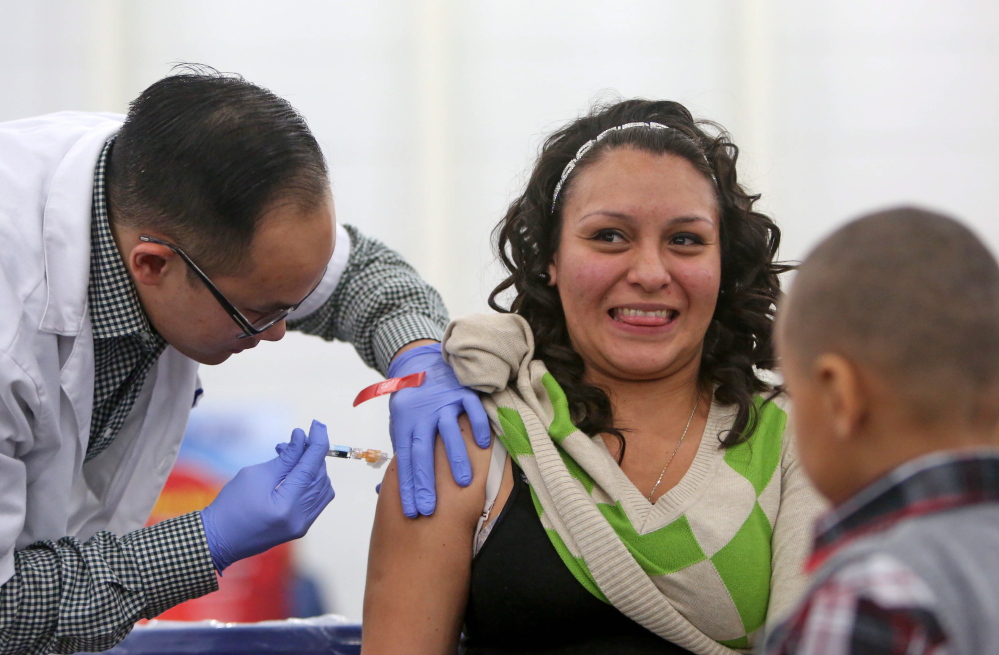Deaths due to influenza and pneumonia have hit “epidemic” levels in the U.S. as flu activity became widespread in 36 states, according to the Centers for Disease Control and Prevention.
Officials reported 837 flu and pneumonia deaths to the CDC through its 122 Cities Mortality Reporting System during the 51st week of the year. Those deaths accounted for 6.8 percent of the 12,358 total deaths that week, just meeting the epidemic threshold.
The area that includes cities in Ohio, Michigan, Indiana, Illinois and Wisconsin reported 151 deaths, the most among the nine regions in the system. Another 147 deaths were tallied in the Pacific region, which includes California, Oregon, Washington and Hawaii.
The fewest deaths – 42 – were in the area that includes Minnesota, Iowa, Missouri, Kansas and Nebraska.
Influenza activity was considered “widespread” in 36 states during week 51, according to the CDC’s most recent FluView report. These states included Arkansas, Colorado, Connecticut, Delaware, Florida, Georgia, Illinois, Indiana, Iowa, Kansas, Kentucky, Louisiana, Maryland, Massachusetts, Michigan, Minnesota, Mississippi, Missouri, Montana, Nebraska, New Hampshire, New Jersey, New York, North Carolina, North Dakota, Ohio, Oklahoma, Pennsylvania, South Carolina, South Dakota, Tennessee, Texas, Virginia, Washington, Wisconsin and Wyoming.
Another 10 states (Alabama, Arizona, Idaho, Maine, Nevada, New Mexico, Rhode Island, Utah, Vermont and West Virginia) had “regional” flu activity, two (Alaska and Oregon) and the District of Columbia had “local” activity, and two (California and Hawaii) had “sporadic” flu activity.
At least 2,643 people have been hospitalized with laboratory-confirmed cases of the flu since Oct. 1, the CDC reported. That works out to a hospitalization rate of 9.7 hospitalizations per 100,000 Americans.
But the risk wasn’t the same for all age groups. Senior citizens had the highest hospitalization rate, at 38.3 per 100,000 people. They were followed by children under the age of 5, who were hospitalized at a rate of 13.4 per 100,000.
More than 95 percent of the hospitalizations this flu season were the result of infection with an H3N2 strain of influenza, according to the CDC. Complicating matters is the fact that the H3N2 flu strain that’s dominant in the U.S. right now is not the one that was targeted by the flu vaccines distributed in North America. Those vaccines were designed to fight an H3N2 strain known as A/Texas/50/2012, but only about one-third of the H3N2 viruses the CDC has tested since Oct. 1 are of that type. Most of the rest are of the A/Switzerland/9715293/2013 variety, which emerged in the U.S. in March — after the vaccines were already in production.
The CDC’s surveillance continues to show that the other strains picked for the North American vaccines were on target, including the H1N1 virus A/California/7/2009 and the influenza B viruses Yamagata/16/88 and B/Victoria/02/87.
The FluView report also notes that all of the virus samples tested this fall have been susceptible to the main-line medicines Tamiflu (oseltamivir) and Relenza (zanamivir) as well as a new drug called Rapivab (peramivir).
Send questions/comments to the editors.



Comments are no longer available on this story